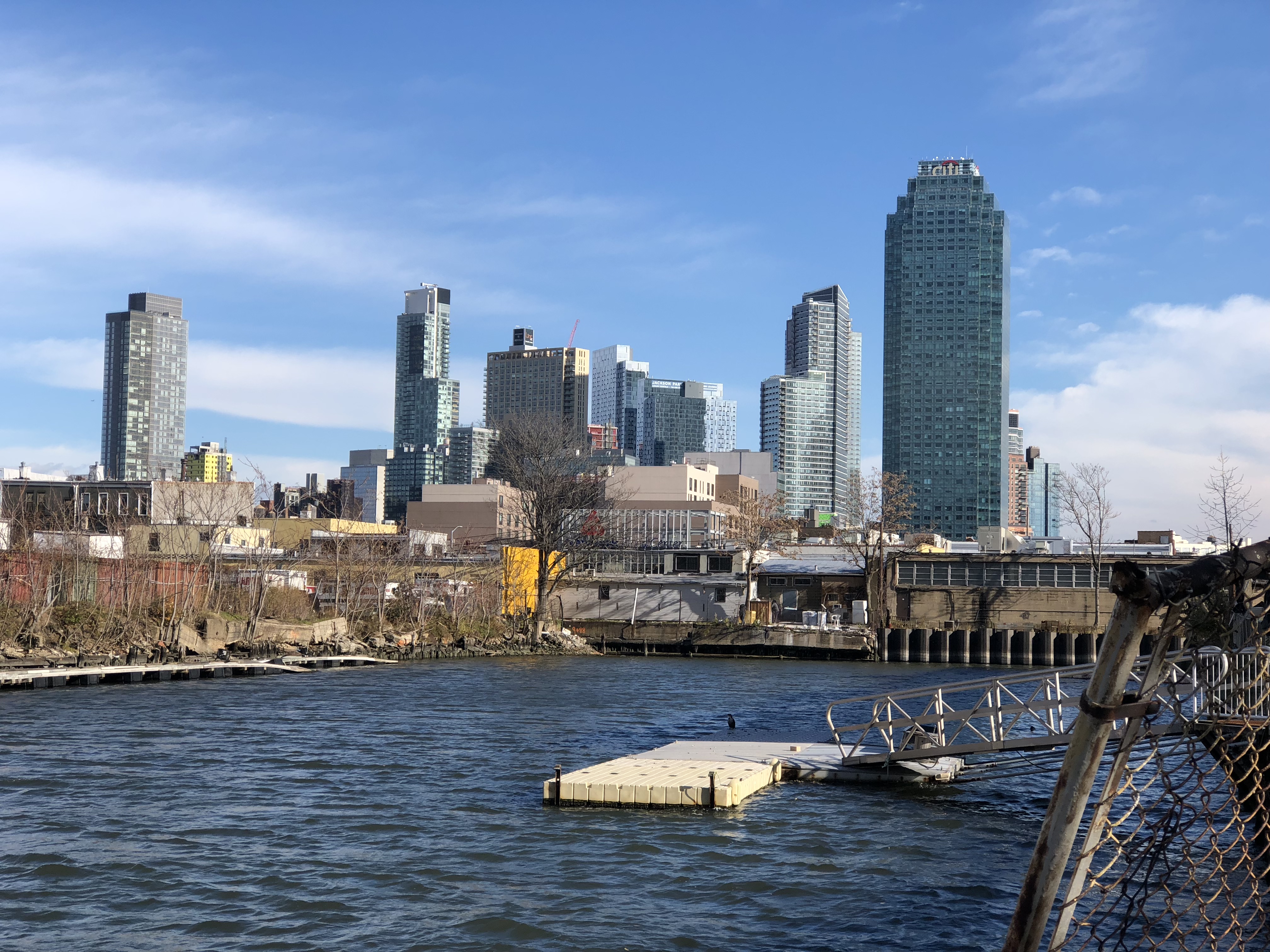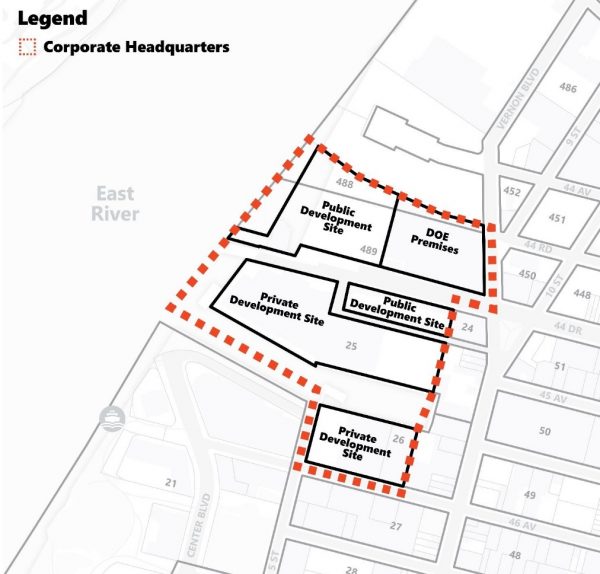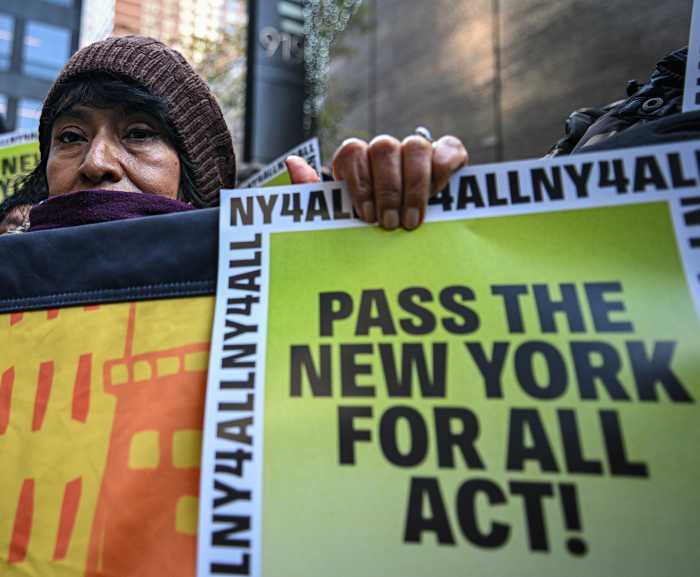
Anable Basin today, where Amazon will build its headquarters. (Photo: Nathaly Pesantez)
Nov. 20, 2018 By Nathaly Pesantez
Update 11/21 : Council Member Jimmy Van Bramer and State Senator Michael Gianaris announced last night that they will not be participating in the Community Advisory Council set to be created as part of the General Project Plan.
“This Community Advisory Council is a thinly veiled attempt to present the Amazon development as a fait accompli and move the discussion towards how to accommodate their entrance to the community,” the two said in a joint statement. “As we have made abundantly clear, we oppose the deal to bring Amazon to Long Island City and continue to fight against it. We will not participate in the Community Advisory Council, whose purpose is to give local validation to a project we are working to stop in its tracks.”
Amazon is likely to begin building out its Long Island City headquarters in 2020, with the city and state both pledging a lineup of opportunities for the public to shape facets of the project well before construction takes off.
The city Economic Development Corporation and Empire State Development, which held a local media briefing on Monday, said a 14-month process is now in the works where the public, by way of meetings, hearings, newly-formed advisory committees and more, will help dictate the buildout of the e-commerce giant’s expansive campus at Anable Basin.
Officials stressed at the briefing, which comes just a week after Amazon officially announced its new headquarter locations to much buzz and criticism over its proceedings, that now begins a “very public conversation” on a campus that Amazon is anticipated to begin moving into in 2022.
“A lot of folks have reacted to this thinking that this is a fully designed project,” said James Patchett, president of NYC EDC. “The truth of the matter is it’s not.”
The 14-month planning process, anticipated to wrap up in early 2020 and with Amazon likely putting shovels on the ground immediately after, will result in the state’s plan that aims to rezone the basin and bring about Amazon’s development, officials said.
The outline, also known as the General Project Plan (GPP), will dictate elements like the size and scope of what the company can actually build on site, along with other uses.

Amazon headquarter location in Long Island City
“We need to work with the community to determine where the buildings will go on the sites, how many square feet will actually go there, what the height limits will be, how they’ll be designed, how they’ll be integrated with the community…” Patchett said. “All of that will be part of the conversation.”
The plan also builds on the components already nailed down in Amazon’s upcoming 4 million square foot development, like a school, open space, and a workforce training center, as part of the company’s memorandum of understanding with the city and state.
“In terms of land use, there is no existing design for these sites,” Patchett said.
Included in the months-long planning is an environmental review process, set to start soon and which officials highlight as one of the ways the local community can make their voices heard.
The public, like in all environmental review proceedings, can give input on what should be looked at when determining the impact of Amazon’s development on the surrounding neighborhood in areas like infrastructure, noise, air quality, traffic, parking and more.
Input is typically given during public scoping meetings and open comment sections, which will likely kick off in 2019.
Amazon, meanwhile, is expected to hand in a plan within the next two months that will give the state a starting point in how to think of the project’s environmental review process, according to Holly Leicht, ESD executive vice president of real estate development and planning.
While Leicht says Amazon would ostensibly begin construction after the 14-month process ends in 2020, the deal signed with the city and state says the company will commence construction within a year of the GPP’s final approval.
While the environmental review takes shape, the GPP will also begin to be drafted, which will be done in coordination with a soon-to-be-formed Community Advisory Committee—yet another way both city and state say the public will be represented in planning.
This committee, typically established in GPPs, includes local elected officials at the state and city level. State Sen. Michael Gianaris and Council Member Jimmy Van Bramer—both of whom have opposed several facets of the deal Amazon struck with the city and state , will be invited to the committee, and can appoint people to the group, too.
Officials say they are in conversations now with elected officials about the committee, and expect its makeup and launch to be finalized within the next week.
City and state officials, along with Amazon representatives, will also head to local community boards to present on plans and milestones “multiple times” and hear feedback over the course of the roughly year-long process.
While the GPP will have its own advisory board, another one will be formed to help steer the Long Island City Infrastructure Fund, one facet of Amazon’s deal with the city and state. The fund is set to receive $650 million from Amazon over the course of 40 years in payments that would otherwise go toward property taxes. The funds, as the name suggests, will go to infrastructure improvements outside of the company’s headquarters, but still within the neighborhood.
The advisory board will also be set up with chairs identified by local electeds. Separate public meetings and forums, additionally, will be held to consider projects that could be aided from the fund.
“It’s very important to us that this be a community focused conversation,” Patchett said.
The city and state made the case for the upcoming public engagement opportunities as the Amazon deal was slammed with criticism from elected officials and locals for its secretive negotiations and use of a state GPP.
The negotiations and choice to executive a state-run land use process were both viewed by critics as methods to circumvent the public’s input at the local and city level.

Council Member Jimmy Van Bramer (left) and State Senator Michael Gianaris. (Photo: Nathaly Pesantez)
“It’s a direct assault on community engagement and consultation on a project that would change the face of Queens,” Van Bramer said leading up to the official Amazon announcement.
The city, however, said Amazon’s decision process was the only private facet of the ordeal, and something they were willing to sign on to given the magnitude and competitiveness of the project, like the rest of the participating cities.
Now, as part of future proceedings, Amazon is expected by both the city and state to be involved in community and even press engagement on its project.
“This project will not be a success unless they are real partners in the community,” Patchett said about Amazon. “It’s their obligation—and we’ll hold them to that—to become real members of the community.”
Amazon’s Anable Basin campus could span up to 8 million square feet and provide around 40,000 jobs over the course of 15 years.
The company will be temporarily occupying 1 million square feet at One Court Square as the buildout along the Long Island City waterfront is underway.




































